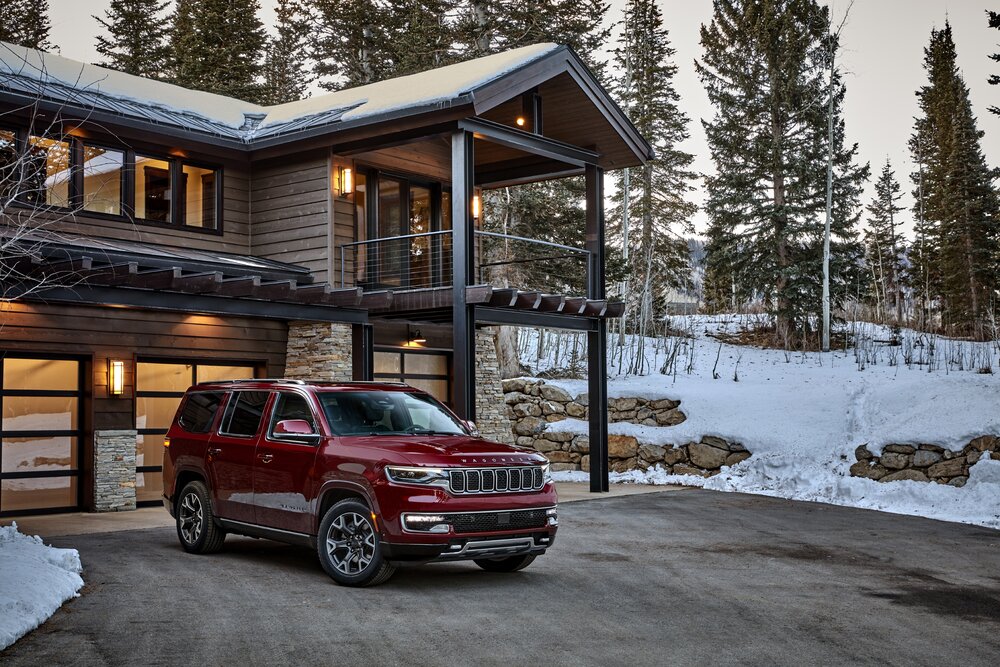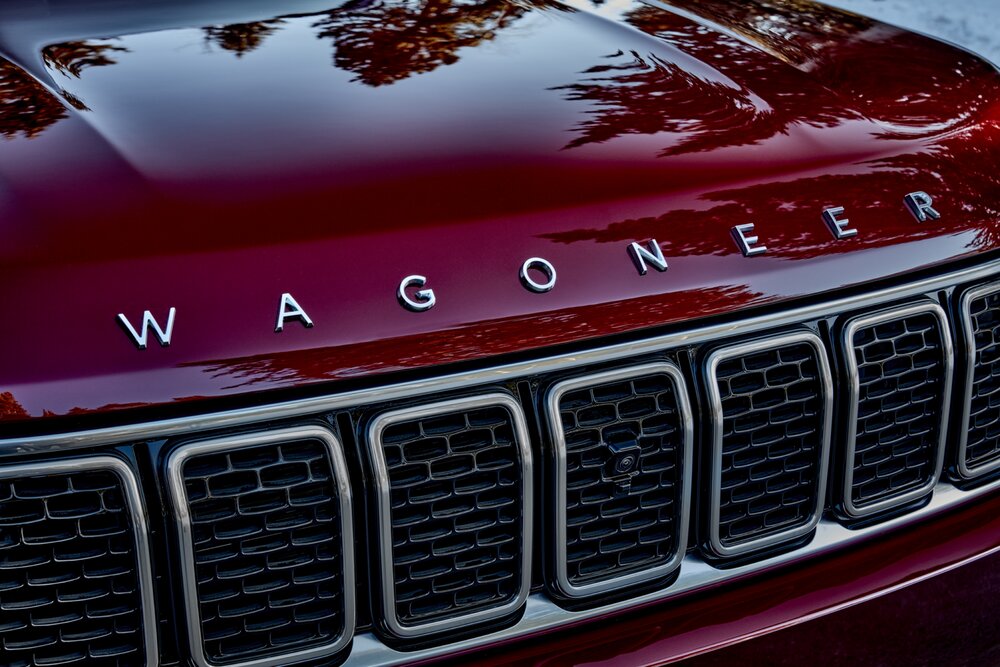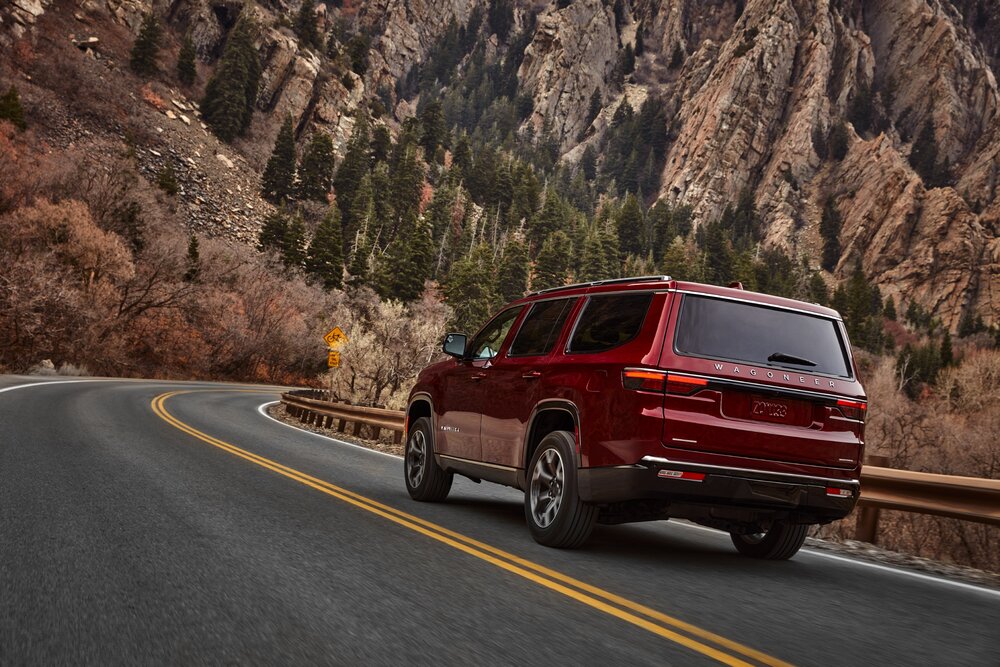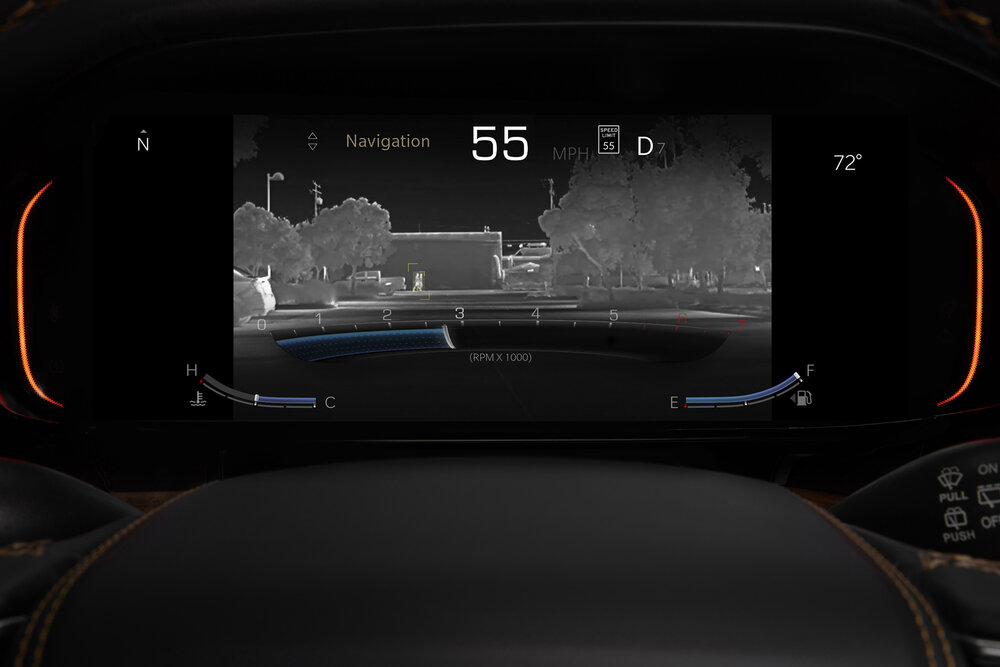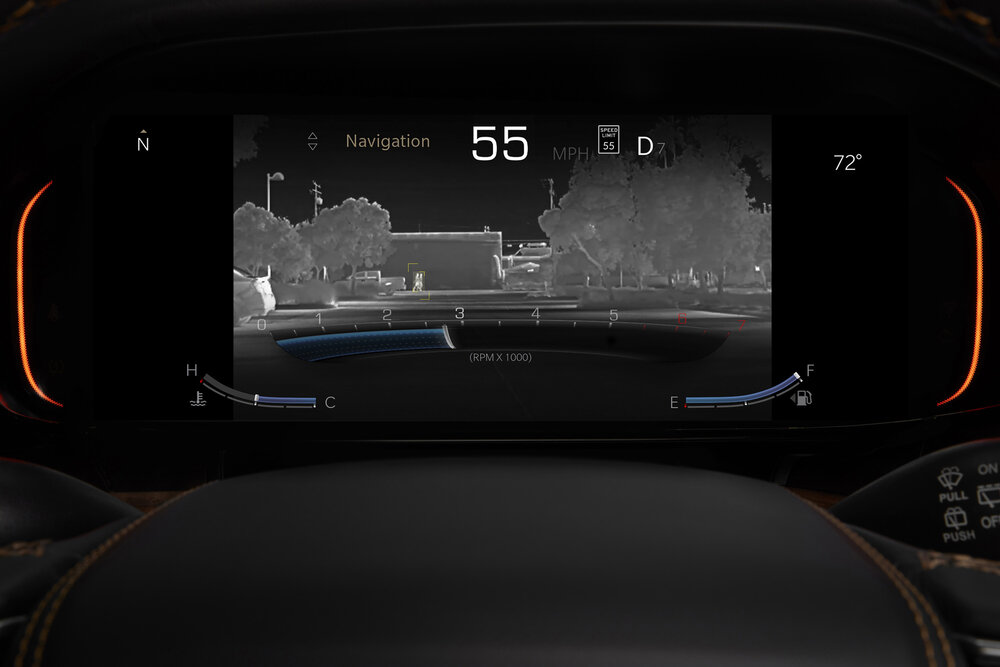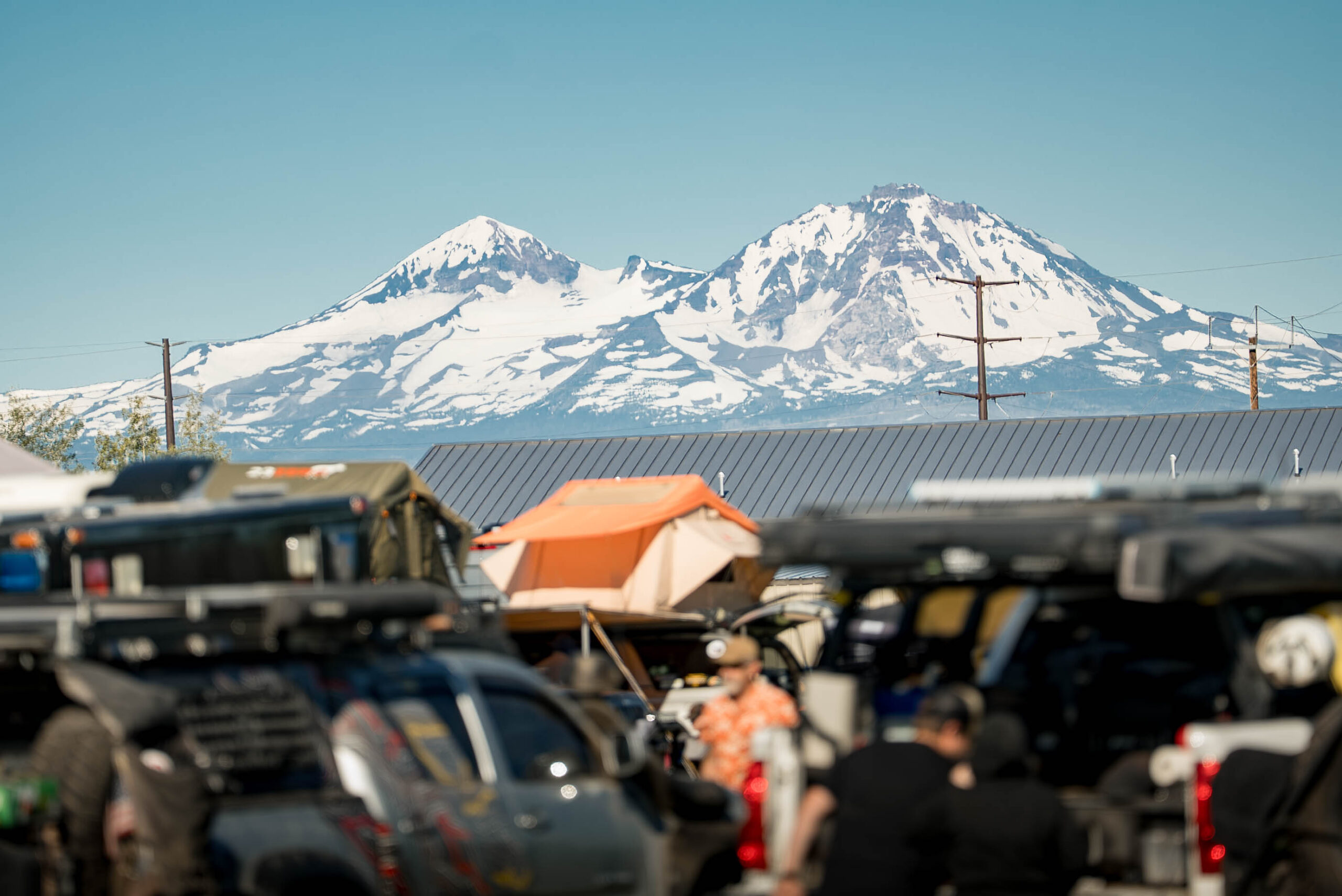While certain automakers are backing away from the ultra-luxury sport utility market, Jeep is doubling down in a big way with the resurrected Jeep Wagoneer and Grand Wagoneer. Jeep was the quintessential creator of the luxury sport utility vehicle segment with the Super Wagoneer released in 1966.
The original Jeep Wagoneer was the first sport utility with now-standard amenities like air conditioning, tilt steering, power steering and brakes, and a console-shifted automatic transmission. Many of us have fond memories of camping trips and family vacations in the Jeep Wagoneer luxury-liners that were discontinued in 1991 after an impressive 29 years in production.
The 2022 Jeep Wagoneer and Grand Wagoneer models draw on the nostalgia of the sport wagons of old while throwing down a gauntlet of technology, comfort, and performance that might solidify Jeep as a leader in the luxury sport utility segment. If the newly released Jeep Cherokee L was a hint that Jeep was entering the luxury SUV market, the secret is out with the new Wagoneer and Grand Wagoneer.
READ MORE: IS JEEP’S ALL-NEW GRAND CHEROKEE ‘L’ TOO LARGE FOR OVERLANDING?
Most importantly, the Wagoneer is poised to be a promising overlanding vehicle for the traveler with style, comfort, and high performance at the top of mind that isn’t fazed by the price tag.

Luxury
If there were a single word to describe the new Wagoneer, it is luxury. From a distance, it seems like the exterior is made of glass due to the long body lines and the presence of a lot of, well, glass. The exterior lines are sleek and sharp and terminate at the grill — a near copy of the iconic piece from the original Wagoneer.
The designers at Jeep clearly spent the majority of their effort creating an interior that is comfortable and technologically connected for eight passengers. In most vehicles equipped with a third row, the rear passengers are often cramped and uncomfortable. Passengers in the third row of the Wagoneer will experience class-leading 36.6 inches of legroom creating comfortable seating for passengers over six feet tall.
All seats are covered in Nappa leather standard and have 12-point adjustability, with Series II and III Grand Wagoneers receiving the option for Palermo leather throughout and 24-point adjustable power seats. First and second row seats in the Grand Wagoneer models are heated/ventilated, massaging, and memory enabled.
Much like the Wagoneers of yesteryear, the most striking area of the interior is the dash and center console. The sweeping leather dash, accented with wood and chrome, brings the eyes back to the massive center infotainment screen, discussed in detail a bit later. The dash accents vary by trim level with an available embossed aluminum dash accent on the Grand Wagoneer.
At the center of the seemingly floating center console is the illuminated aluminum shift knob and toggle switches for the various ride height and Selec-Terrain systems. All interior courtesy and entry/exit lights can be configured as a part of the five-color ambient lighting system creating a relaxed and comfortable atmosphere.
READ MORE: GARMIN’S OVERLANDER MAKES WINGING IT EASIER THAN EVER
The cockpit is comfort-focused with seat adjustment buttons on the upper door panel to make room for the “EST. 1963” nameplate along the exterior-facing side of the seat. Jeep designers maintained the traditional two-spoke steering wheel from the original Wagoneer and added a modern push-button start with a raised metal surround, flanked by French accent leather stitching on Grand Wagoneer models.
The frameless 10.25-inch digital gauge cluster is extremely customizable with the ability to pick up to five tiles that are reconfigurable from two dozen options such as vehicle speed, tire pressure, driver assist modules, and even night vision. All models of Wagoneer and Grand Wagoneer are outfitted with an up to 10-inch heads-up display (HUD) on the inside of the windshield capable of displaying one of the three predefined configurations, all in full-color.
The interior is not something you would expect to find inside of a Jeep, and that is a good thing. The build quality and amenities of the interior surpass the luxury sport utility offerings from other domestic manufacturers and more closely resemble the quality that has been offered by Japanese and German car makers for years. The combination of high-quality materials, class-leading legroom and cargo space, and subtle nods to the past make the interior of the Wagoneer a sight to behold.
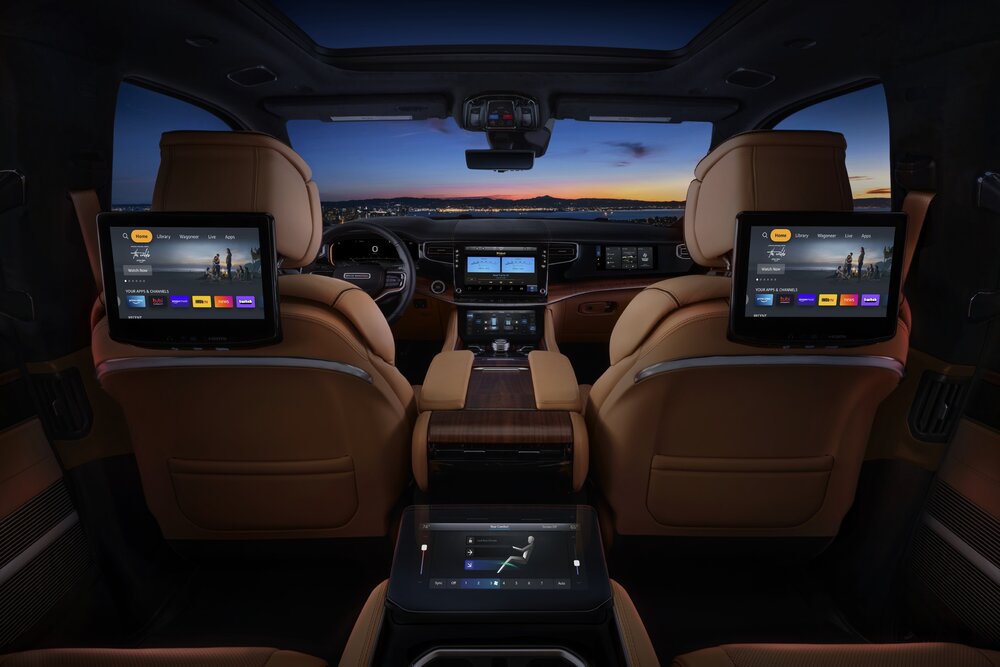
Technology
The days of bringing along an iPad for each of your children on a trip to the mountains or the grocery store are over as the new Wagoneer is fitted with up to 50 inches of screen and 75 inches on the Grand Wagoneer. As a part of the Uconnect 5 infotainment system, each second row passenger has access to their own 10.1-inch touch screen that can be controlled by the available front passenger 10.25-inch touchscreen.
The front passenger screen has the ability to control the navigation, entertainment (front and rear) including the integrated Fire TV, and the ability to view the vehicle’s exterior cameras as well as the optional interior third-row camera. The front passenger screen is tilted away from the driver and covered in a film designed to prohibit the driver from being able to see it.
Wagoneer was designed with connected entertainment as a priority and the Uconnect 5 system, reportedly five times faster than previous versions, allows for maximum integration with the world wide web and the outside world. Each Wagoneer is equipped with a 4G LTE hotspot capable of providing connectivity for up to eight passengers as well as a variety of USB ports that will allow each passenger to charge a device simultaneously. The convenience of Apple CarPlay and AndroidAuto is dwarfed by the sheer amount of tech available in the Wagoneer.
Wagoneer is the first example of Fire TV Auto integration and each screen can stream individually or in tandem any of the thousands of shows and movies available on Fire TV for those trips when the splendor of nature is simply not enough to subdue your kids in the backseats. Content can be downloaded for offline viewing allowing you to keep a few movies in your virtual back pocket for when you invariably lose service and need to provide some entertainment.
READ MORE: GEAR ESSENTIALS: CAMPING GEAR & APPAREL
Available on the Wagoneer Series III and all Grand Wagoneer models is a McIntosh sound system designed to provide studio-quality sound for all passengers. The Wagoneer Series III and Grand Wagoneer Series I and II are available with the McIntosh 19-speaker sound system complete with a 10-inch subwoofer and 950-watt amplifier. Available on the Grand Wagoneer Series I and II and standard on the Series III is a 23-speaker system with a 12-inch subwoofer and a 1375-watt amplifier that provides a 3D sound similar to what you would experience at a concert venue or recording studio. The iconic styling of McIntosh audio components is evident in the retro audio display and blue backlit logos on each speaker grill.

Capability
The Jeep Wagoneer is not Trail Rated by Jeep, but not for lack of trying. At nearly 18 feet long with a 123-inch wheelbase, the Wagoneer and Grand Wagoneer are simply too long to be considered for Jeep’s badge of capability. With the 6,400-pound elephant in the room out of the way, prospective buyers shouldn’t be discouraged by the size of the Wagoneer. Because what it lacks in maneuverability, it makes up for in interior capacity, best-in-class tow rating, and a ton of power. Jeep designers describe the ideal Wagoneer customer not as someone who will tackle the Rubicon trail, but someone interested in hauling a camper or trailer full of off-road vehicles to a cabin, trailhead, or campsite that most won’t try to get to. Due to a fully integrated trailer hitch between the frame rails, the Wagoneer is rated to tow 10,000 pounds when equipped with the 5.7-liter V8.
Three available four wheel drive systems as well as an optional Quadra-Lift air suspension system and Selec-Terrain traction management system should provide plenty of travel and traction for most average users trying to get off-pavement. The two-speed transfer case available on the Quadra-Trac II system is able to detect wheel slippage and deliver up to one hundred percent of available torque to the wheel with the most traction.
READ MORE: A FIRST-TIMER’S BORDER CROSSING INTO BAJA, MEXICO
Selec-Terrain provides five different settings for various conditions: Auto, Sport, Rock, Snow, and Sand/Mud. Utilizing sensors in twelve different systems throughout the vehicle, Selec-Terrain electronically coordinates vehicle performance output by way of 4×4 torque split, throttle control, transmission shift points, and hill-descent speed control.

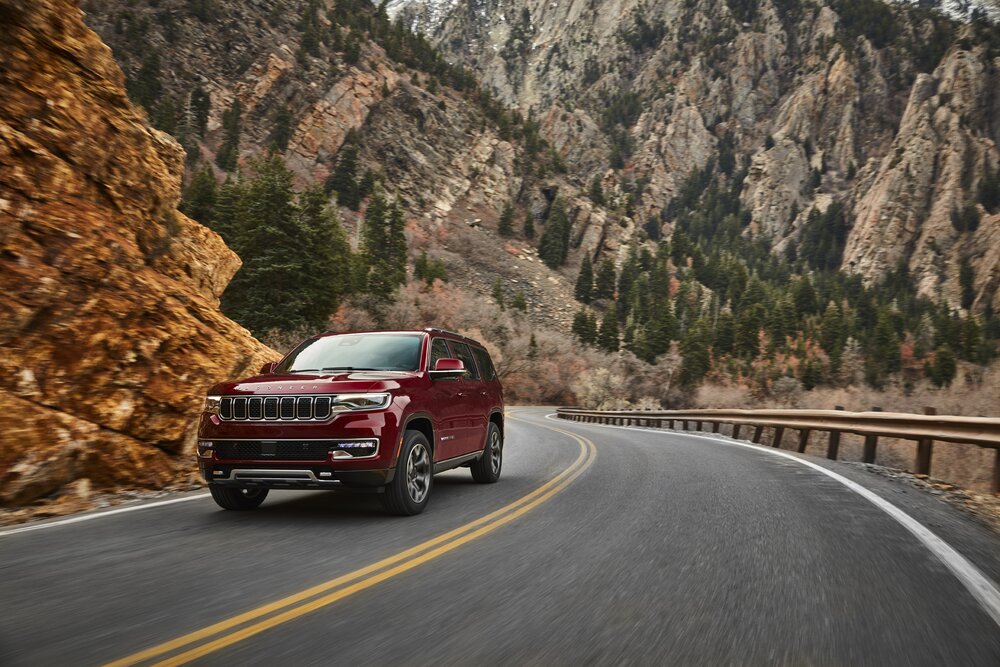


The available Quadra-Lift air suspension controls air bags on all four corners to provide a more comfortable ride while being adjustable off-road. In Off-Road II mode, one of the five suspension height settings, the suspension rises two inches to provide ten inches of ground clearance. Conversely, once you leave the trail, activating Aero mode will lower the vehicle to normal ride-height and lower front suspension and additional half-inch for improved aerodynamics and fuel efficiency for the drive home. The Quadra-Lift suspension, paired with the Trail Hitch Line-Up Assist rear camera, makes backing up and connecting a trailer a snap.
Despite the length of the Wagoneer, with a 25-degree approach angle, a 24-degree departure angle, and a 22-degree breakover angle, it is positioned to be a more compelling off-road rig than competitors such as the Ford Expedition and Lincoln Navigator. At its highest suspension setting the Wagoneer can reportedly ford water up to 24 inches deep, just six inches shy of the 2020 Jeep Wrangler.

Models
Jeep released both a 2022 Jeep Wagoneer and Jeep Grand Wagoneer and the difference comes down to the addition of more luxury features and a heap of additional performance. You will be able to spot the Grand Wagoneer from a distance due to the distinct two-tone black roof and the location of the front badging on the top of the grill versus the front of the hood on the standard Wagoneer. The LED headlights, fog lights, and taillights are more refined on the Grand Wagoneer and exterior features like the retractable side steps and fender flares mark the more elegant of the two models.
The most noticeable difference between the two models is under the hood. The Wagoneer is only available with the 5.7 liter V8, producing 392 horsepower and 404 foot pounds of torque. Instead of a traditional alternator, the Wagoneer is outfitted with a belt-powered motor generator and a 48-volt battery pack to allow for quick on/off transitions, brake recapture, and an additional 130 lb.-ft of torque available under certain conditions. With a 3.21 axle ratio and a 10,000-pound towing capacity, the Wagoneer has class-leading towing capabilities.
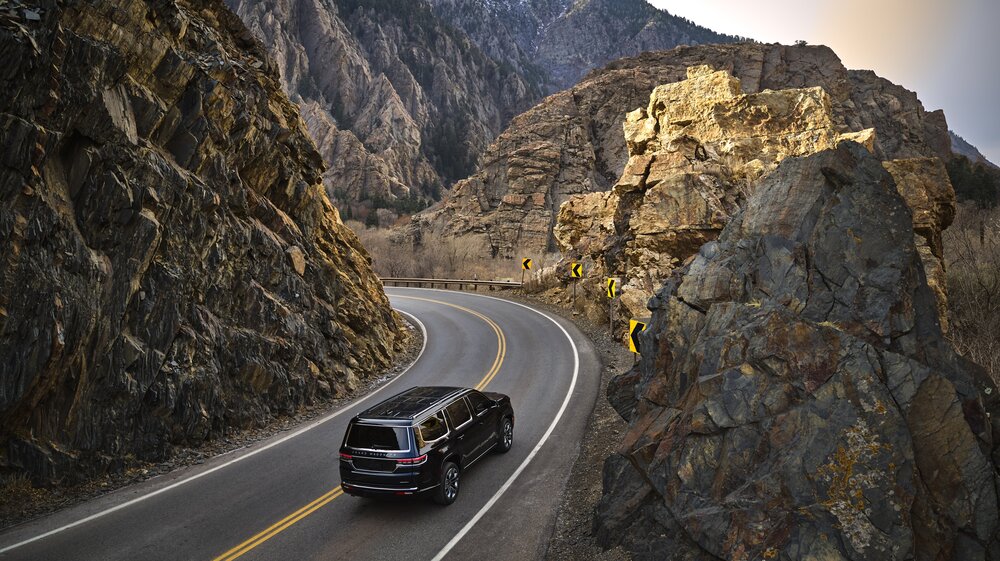


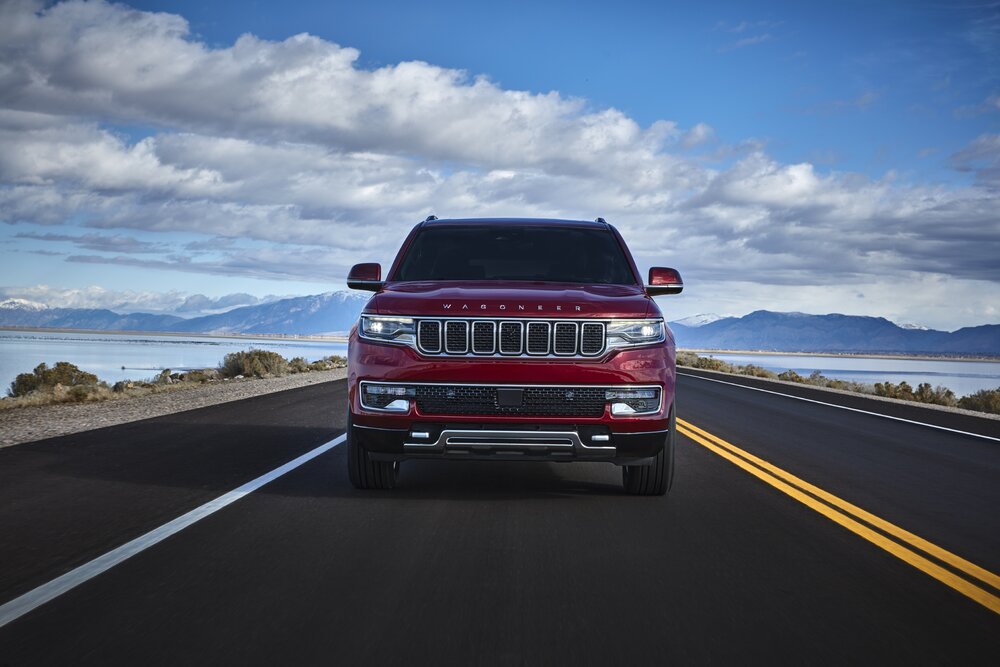
The Grand Wagoneer comes standard with the same 392 that Jeep dropped in the 2021 Wrangler Rubicon — a 6.4-liter V8 pumping out 471 hp and 455 lb.-ft of torque. Although a 0-60 time of 6.0 seconds isn’t that important for crawling to your favorite campsite, being first in the school pickup line is never a bad thing. Jeep has shown a dedication to providing high-performance engine options in production models, is it only a matter of time before we see a Jeep Wagoneer Hellcat?
The available trim levels are a bit confusing at first, with both the Wagoneer and Grand Wagoneer available in a Series I, II, and III. The Wagoneer is available in two-wheel drive or four-wheel drive in all three trim levels, where the Grand Wagoneer is available only in four-wheel drive. The Obsidian trim comes outfitted with blacked out exterior accents, black 22-inch wheels, and a blacked out leather interior.
READ MORE: TRIPS & TRAILS: BODIE GHOST TOWN
The Jeep Wagoneer Series II 4×4 (the cheapest four wheel drive trim) will start at $70,995 and the Wagoneer Series III 4×4 will MSRP at $75,995. The more luxurious Grand Wagoneer Series I will start at $86,995 and the Grand Wagoneer Series III Premium will MSRP for $107,980. There will be twelve preconfigured Wagoneer and Grand Wagoneer models available at Jeep dealers beginning in the second half of 2021.
Selecting the right overland vehicle comes down to which vehicle presents the best combination of capability, comfort, and value for any given traveler. And although the Wagoneer and Grand Wagoneer are targeted at high-end customers that prioritize style, status, and convenience above all else, there is little reason to think that these vehicles won’t be a top choice for overlanders with a big budget that don’t need the capability of a Ford Bronco or Jeep Gladiator. The combination of really good performance on and off road as well as one of the most visually impressive and functional interiors in the full size SUV segment is going to be hard to beat, even at such a high price.
Photos by: Jeep
Overlanding Industry News by Zach Elseman. Follow Zach @okienomads.
